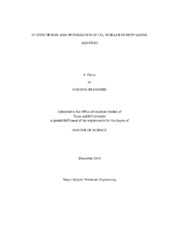| dc.contributor.advisor | Jafarpour, Behnam | |
| dc.creator | Shamshiri, Hossein | |
| dc.date.accessioned | 2012-02-14T22:18:59Z | |
| dc.date.accessioned | 2012-02-16T16:13:35Z | |
| dc.date.available | 2012-02-14T22:18:59Z | |
| dc.date.available | 2012-02-16T16:13:35Z | |
| dc.date.created | 2010-12 | |
| dc.date.issued | 2012-02-14 | |
| dc.date.submitted | December 2010 | |
| dc.identifier.uri | https://hdl.handle.net/1969.1/ETD-TAMU-2010-12-8969 | |
| dc.description.abstract | Optimization of waterflooding sweep efficiency has been widely applied in reservoir
engineering to improve hydrocarbon recovery while delaying water breakthrough and
minimizing the bypassed oil in reservoirs. We develop a new framework to optimize
flooding sweep efficiency in geologic formations with heterogeneous properties and
demonstrate its application to waterflooding and geological CO2 sequestration problems.
The new method focuses on equalizing and delaying (under constant total injected
volume) the breakthrough time of the injected fluid at production wells. For application
to CO2 sequestration where producers may not be present, we introduce the concept of
pseudo production wells that have insignificant production rates (with negligible effect
on the overall flow regime) for quantification of hypothetical breakthrough curves that
can be used for optimization purpose. We apply the new method to waterflooding and
CO2 sequestration optimization using two heterogeneous reservoir models. We show that
in water flooding experiments, the proposed method improves the sweep efficiency by
delaying the field breakthrough and equalizing breakthrough times in all production
wells. In this case, the optimization results in increased oil recovery and decreased water
production. We apply a modified version of the proposed algorithm to geologic CO2
sequestration problems to maximize the storage capacity of aquifers by enhancing the
residual and dissolution trapping. The results from applying the proposed approach to
optimization of geologic CO2 storage problems illustrate the effectiveness of the
algorithm in improving residual and solubility trapping by increasing the contact between available fresh brine and the injected CO2 plume through a more uniform
distribution of CO2 in the aquifer. | en |
| dc.format.mimetype | application/pdf | |
| dc.language.iso | en_US | |
| dc.subject | CO2 | en |
| dc.subject | sequestration | en |
| dc.subject | storage | en |
| dc.subject | optimization | en |
| dc.title | System Design and Optimization of CO2 Storage in Deep Saline Aquifers | en |
| dc.type | Thesis | en |
| thesis.degree.department | Petroleum Engineering | en |
| thesis.degree.discipline | Petroleum Engineering | en |
| thesis.degree.grantor | Texas A&M University | en |
| thesis.degree.name | Master of Science | en |
| thesis.degree.level | Masters | en |
| dc.contributor.committeeMember | Gildin, Eduardo | |
| dc.contributor.committeeMember | Bhattacharyya, Shankar | |
| dc.type.genre | thesis | en |
| dc.type.material | text | en |


